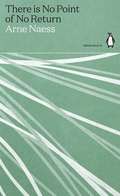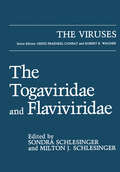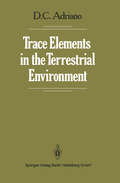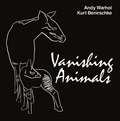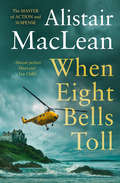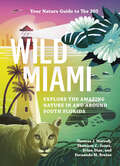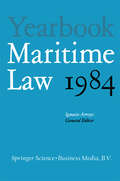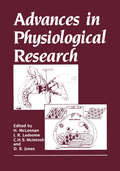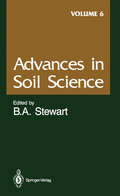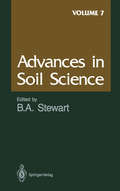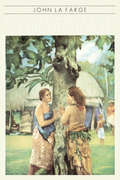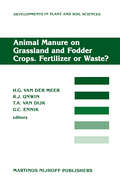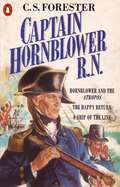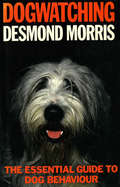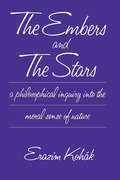- Table View
- List View
There is No Point of No Return (Green Ideas)
by Arne NæssIn twenty short books, Penguin brings you the classics of the environmental movement.Emphasizing joy in the world, human cooperation and the value of all living things, this selection of Arne Naess' philosophical writings is filled with wit, learning and an intense connection with nature.Over the past 75 years, a new canon has emerged. As life on Earth has become irrevocably altered by humans, visionary thinkers around the world have raised their voices to defend the planet, and affirm our place at the heart of its restoration. Their words have endured through the decades, becoming the classics of a movement. Together, these books show the richness of environmental thought, and point the way to a fairer, saner, greener world.
The Togaviridae and Flaviviridae (The Viruses)
by Sondra Schlesinger Milton J. SchlesingerThe publication of this volume of The Viruses entitled The Togaviridae and Flaviviridae comes at an appropriate time. The structure and rep lication strategies of these viruses are now known to be sufficiently di verse to warrant the removal of flaviviruses from the Togaviridae family and establish them as an independent family. Flaviviridae have a special place in the history of virology. The prototype virus-yellow fever virus was the first virus to be identified as the cause of a human disease. Some of the history of this discovery is described in Chapter 1 of this volume; in Chapter 10 the complete sequence of the RNA genome of the virus is presented. This sequence not only defines the primary structure of the viral proteins, it also clarifies the mechanism of translation of the fla vivirus genome. Knowledge of the sequence of the structural proteins of these viruses represents an important step in the potential goal of using purified flavivirus glycoproteins as vaccines. Many of the chapters in this volume focus on the structure and replication of the Togaviridae. These viruses have provided valuable models for studies in cell biology, partic ularly with regard to the cotranslational and posttranslational steps re quired for the synthesis and localization of membrane glycoproteins. Fur thermore, Togaviridae have been pivotal in our growing understanding of how enveloped viruses enter and exit from cells. The broad outlines of the structure and gene expression of Togavir idae and Flaviviridae are known, but important questions remain.
Trace Elements in the Terrestrial Environment
by Domy C. AdrianoI intend to fill, with this book, a need that has long been felt by students and professionals in many areas of agricultural, biological, natural, and environmental sciences-the need for a comprehensive reference book on many important aspects of trace elements in the "land" environment. This book is different from other books on trace elements (also commonly referred to as heavy metals) in that each chapter focuses on a particular element, which in tum is discussed in terms of its importance in our economy, its natural occurrence, its fate and behavior in the soil-plant system, its requirement by and detriment to plants, its health limits in drinking water and food, and its origin in the environment. Because of long distance transport to pristine areas of cadmium, lead, copper, and zinc in relatively large quantities, these elements have an extra section on natural ecosystems. A blend of pictorial and tabular data are provided to enhance understanding of the relevant information being conveyed. Since individual chapters are independent of one another, they are arranged alphabetically. However, readers with weak backgrounds in soil science are advised to start with the chapter on zinc, since soil terminology is discussed in more detail here. Sections on sorption, forms and speciation, complexation, and transformations become more technical as soil physical-(bio )chemical phenomena are discussed. The less important "environmental" trace elements are discussed together in the "Other Trace Elements" chapter.
Vanishing Animals
by Andy Warhol Kurt BenirschkeEspecially for this book, Andy Warhol has created prints (silkscreen over collage) of some of the most endangered animals in the world. Here they are joined with a stimulating text by Dr Kurt Benirschke affording the reader an opportunity to discover the lives and habits of these animals and what the outlook is for their survival.Extinction, the tragic and permanent loss of entire species of animals, should be a concern for everyone This concern and a strong desire to take action toward preventing the loss of more animals has brought about an unusual collaboration between art and science. The result is this beautiful volume in which artist and scientist have joined efforts to inform and inspire others to take action. It is hoped that these fascinating and striking portrayals will stimulate readers to join their own energies and talents to this important fight against the loss of more species. This book brings some of the less well known endangered animals to the reader's attention. These animals deserve just as much attention as the giant panda or the mountain gorilla about which so much has already been said. Naturally, the animals presented here are very personal choices, having been selected from a virtually endless supply of animals whose last hour is rapidly approaching.
When Eight Bells Toll
by Alistair MacLeanFrom the acclaimed master of action and suspense. The all time classic
Wild Miami: Explore the Amazing Nature in and Around South Florida
by TJ Morrell Shannon Jones Brian Diaz Fernando BretosA vibrant, informative guide to the unexpected nature found in and around Miami.
Yearbook Maritime Law: Volume I
by IgnacioArroyoI. The importance of legal questions related to the sea is obvious to everyone. It is hardly surprising that the subjects that make up international current events illustrate the leading role played by maritime affairs. Indeed, it is no coincidence that three quarters of the earth's surface is covered by oceans. Territorial seas, exclusive economic zones, exploitation of the seabed, fishing, transport, insurance, collision, and pollution raise many unresolved questions. On the other hand, the contrast of this importance with the modest attention that existing periodical publications merit must be underscored. Without undervaluing these publications, there has been a need for some time to create a vehicle of common expression, based on three central tenets: interdisciplinary framework, tendency towards uniform law, and both a theoretical and practical approach. a. A framework of interdisciplinary nature seems to be relevant as it is desirable to overcome the artificial separation between public and private law.
Advances in Physiological Research
by H. McLennan J.R. Ledsome C.H.S. McIntosh D.R. JonesThe XXX Congress of the International Union of Physiological Sciences took place in Vancouver, Canada, in July 1986; and this Volume contains a selection of the Review Lectures which formed part of the Congress programme. They cover most of the areas of contemporary physiology and were presented by distinguished scientists from many parts of the world. An innovation at this Congress was the inclusion in the programme of a number of lectures devoted to historical subjects. These lectures attracted large audiences at the meetings, and three of them also appear in this book. Finally, the Plenary Lectures which formed part of the opening and closing ceremonies and which deal with some aspects of Canadian physiological history, find a place here as well. The Editors are grateful to all of the authors who provided the manuscripts which go to make up this book, and to John Donald for his invaluable assistance in the preparation of the final text; as well of course to all of the contributors whose participation made the Congress the success which it was. It is hoped that this Volume will provide a useful memento of the event.
Advances in Soil Science (Advances in Soil Science #6)
by R. R. Allmaras S. C. Gupta J. Kubota A. D. Scott S. J. Smith D. L. Sparks M. E. Sumner D. Van Campen J. L. Walworth R. M. WelchThe world needs for food and fiber continue to increase. Population growth in the developing countries peaked at 2. 4 percent a year in 1965 and has fallen to about 2. I percent. However, in many developing countries almost half the people are under 15 years of age, poised to enter their productive and reproductive years. The challenges to produce enough food for this growing population will remain great. Even more challenging is growing the food in the areas of greatest need. Presently the world has great surpluses of food and fiber in some areas while there are devastating deficiencies in other areas. Economic conditions and the lack of suitable infrastructure for distribution all too often limit the alleviation of hunger even when there are adequate supplies, sometimes even within the country itself. World hunger can only be solved in the long run by increasing crop production in the areas where the population is growing most rapidly. This will require increased efforts of both the developed and developing countries. Much of the technology that is so successful for crop production in the developed countries cannot be utilized directly in the developing countries. Many of the principles, however, can and must be adapted to the conditions, both physical and economic, of the developing countries. This series, Advances in Soil Science.
Advances in Soil Science (Advances in Soil Science #7)
by D. W. Anderson E. Bresler W. W. Frye L. Metzger M. S. Smith J. J. Varco J. Venkateswarlu B. YaronThe world population in 1950 was 2. 5 billion and is more than 5 billion today. The agriculture community, however, has responded remarkably well to meeting the increased need for food and fiber. While the population growth during this period averaged almost 2% annually, the production of grain increased at an even faster rate. From 1950 to 1973, grain production increased 3. 1% annually, but slowed to about 2% from 1973 to 1984. There fore, as a whole, the world has more grain per capita available today than ever before. Several countries that were food importers just a few years ago are food exporters today. The world carry-over stocks today are the highest in years. While the major concern just a few years ago was whether the world could produce adequate food, the problem for many countries today is how to export their surpluses. Although the world as a whole has surplus food supplies, there are millions of people without adequate food to exist, and there are additional millions who have a bare subsistence diet at best. The average daily calorie supply for the developed countries is more than 3,300 per person, while the average for the developing countries is only about 2,200. The major global food produc tion problems have shifted from Asia to Africa, where malnutrition, poverty, and starvation are attracting world attention.
American Artist In The South Sea
by John La FargeThe American artists John La Farge preceded Gauguin to the Pacific, and in their time his reputation as the modern Pacific painter far overshadowed that of the Frenchman. This remarkable work is the record of a year-long artistic odyssey through the South Seas, during which La Farge braved the volcanoes of Hawaii, visited Robert Louis Stevenson in Samoa, was adopted by a noble Tahitian family and journeyed through the wild hills of Fiji, painting and sketching lyrical studies of island life. Lavishly illustrated with his work, this account of the Polynesian adventures that La Farge shared with his friend the historian Henry Adams is an important contribution to the literary and artistic heritage of the Pacific and a revealing insight into the life of a complex and fascinating man.
American Artist In The South Sea
by John La FargeThe American artists John La Farge preceded Gauguin to the Pacific, and in their time his reputation as the modern Pacific painter far overshadowed that of the Frenchman. This remarkable work is the record of a year-long artistic odyssey through the South Seas, during which La Farge braved the volcanoes of Hawaii, visited Robert Louis Stevenson in Samoa, was adopted by a noble Tahitian family and journeyed through the wild hills of Fiji, painting and sketching lyrical studies of island life. Lavishly illustrated with his work, this account of the Polynesian adventures that La Farge shared with his friend the historian Henry Adams is an important contribution to the literary and artistic heritage of the Pacific and a revealing insight into the life of a complex and fascinating man.
Animal Manure on Grassland and Fodder Crops.Fertilizer or Waste?: Proceedings of an International Symposium of the European Grassland Federation, Wageningen, The Netherlands, 31 August–3 September 1987 (Developments in Plant and Soil Sciences #30)
by H. G. Van Der Meer R. J. Unwin T. A. Van Dijk G. C. EnnikOn the occasion of its twenty-fifth anniversary, in 1985, the Netherlands Society for Grassland and Fodder Crops (NVWV) agreed to organize an International Symposium on a topic related to intensive grass and fodder production systems. The theme selected was "Animal manure on grassland and fodder crops: Fertilizer or waste?" This Symposium was organized under the auspices of the European Grassland Federation and held at the International Agricultural Centre in Wageningen from 31 August to 3 September 1987. The problems connected with the disposal of animal waste have received much attention in recent years, especially in regions with intensive animal of animal manure per hectare agricul husbandry. Whereas the production tural land increased strongly, the need for it decreased because of the introduction of cheap inorganic fertilizers which are easier to handle and have a more reliable effect on crop growth. As a consequence, many farmers dispose of animal manure as cheaply as possible, whilst avoiding damage to grassland and crops and paying little attention to effective use of the plants nutrients contained in the manure. Present practices of manure handling and application often lead to environmental problems. The rise in awareness of these problems renewed interest in possibilities to improve the utilization of nutrients from animal manure in crop production. Research on this topic has been stimulated in many countries during the last decade and the aim of this Symposium was to review and assess present-day knowledge.
Avocado Anxiety: and Other Stories About Where Your Food Comes From
by Louise GrayThe food stories behind your favourite fruits and vegetables. Have you ever wondered who picked your Fairtrade banana? Or why we can buy British strawberries in April? How far do you think your green beans travelled to get to your plate? And where do all the wonky carrots go? Above all, how do we stop worrying about our food choices and start making decisions that make a difference?In an effort to make sense of the complex food system we are all part of, Louise Gray decides to track the stories of our five-a-day, from farm to fruit bowl, and discover the impact that growing fruits and vegetables has on the planet. Through visits to farms, interviews with scientists and trying to grow her own, she digs up the dirt behind organic potatoes, greenhouse tomatoes and a glut of courgettes. In each chapter, Louise answers a question about a familiar item in our shopping basket. Is plant protein as good as meat? Is foraged food more nutritious? Could bees be the answer to using fewer chemicals? How do we save genetic diversity in our apples? Are digital apps the key to reducing food waste? Is gardening good for mental health? And is the symbol of clean eating, the avocado, fuelling the climate crisis? As pressure grows via social media to post pictures of food that ticks all the boxes in terms of health and the environment, these food stories from the author of the award-winning The Ethical Carnivore are also a personal story of motherhood and the realisation that nothing is ever perfect.
Captain Hornblower R.N.: Hornblower and the 'Atropos', The Happy Return, A Ship of the Line (A Horatio Hornblower Tale of the Sea)
by C. S. Forester"Hornblower and the Atropos" skippering the flagship for Nelson's funeral on the Thames is not Hornblower's idea of thrilling action. But soon his orders come, and he sets sail for the Mediterranean in the Atropos. 'Battle, storm, shipwreck, disease - what were the chances that he would never come back again?' "The happy return" Hornblower sails the South American waters and comes face to face with a mad, messianic revolutionary in a novel that ripples with risk and gripping adventure. "a ship of the line" commando raids, hurricanes at sea, the glowering menace of Napoleon's onshore gun batteries - Hornblower must deal with them all as he sails his ship to the Spanish station. Throughout his escapades Forester remains gallant, resourceful and courageous - the embodiment of all the most vivid in a great naval tradition.
Cell and Tissue Culture in Forestry: General Principles and Biotechnology (Forestry Sciences #24-26)
by J. M. Bonga D. J. DurzanSince the first edition of our book "Tissue Culture in Fores try" in 1982 we have witnessed remarkable advances in cell and tissue culture technologies with woody perennials. In addition to forest biologists in government, industry, and universities, we now have molecular biologists, genetic engineers, and biochemists using cell and tissue cultures of woody species routinely. There fore, the time has come for an update of the earlier edition. In our present effort to cover new developments we have expanded to three volumes: 1. General principles and Biotechnology 2. Specific Principles and Methods: Growth and Development 3. Case Histories: Gymnosperms, Angiosperms and Palms The scientific barriers to progress in tree improvement are not so much lack of foreign gene expression in plants but our current inabili ty to regenerate plants in true-to-type fashion on a mas sive and economic scale. To achieve this in the form of an appro pr iate biotechnology, cell and tissue culture will increasing ly require a better understanding of basic principles in chemistry and physics that determine structural and functional relationships among molecules and macromolecules (proteins, RNA, DNA) within cells and tissues. These principles and their relationship with the culture medium and its physical environment, principles of clonal propagation, and genetic variation and ultrastructure are discussed in volume one.
Cell and Tissue Culture in Forestry: Volume 2 Specific Principles and Methods: Growth and Developments (Forestry Sciences #24-26)
by J. M. Bonga D. J. Durzan2. 2. Plant materials 2. 3. Pregrowth conditions 2. 4. Cryoprotectant treatment 2. 5. Freezing 2. 5. 1. Slow freezing 2. 5. 2. Rapid freezing 2. 5. 3. Droplet freezing 2. 6. Storage 2. 7. Thawing 2. 8. Viability testing 2. 9. Post-thaw regrowth 3. EXAMPLES OF CRYOPRESERVATION OF WOODY PLANT MATERIAL 4. POTENTIAL APPLICATION OF CRYOPRESERVATION IN TREE IMPROVEMENT 17. NURSERY HANDLING OF PROPAGULES - J. A. Driver, and 320 G. R. L. Suttle 1. INTRODUCTION 2. COMMERCIAL NURSERY NEEDS VS. LABORATORY PRACTICE 3. SEASONALITY OF GROWTH AND PRODUCTION CYCLES 4. MICROPROPAGATION OPTIONS 4. 1. Trends in commercial micropropagation 4. 1. 1. Contract micropropagation 5. FACTORS AFFECTING SURVIVAL AND GROWTH 5. 1. Hardening of propagules in vitro 5. 2. Greenhouse considerationS------ 5. 3. Field planting 5. 4. New approaches: Direct field rooting 5. 4. 1. Pretreatment in vitro 5. 4. 2. Root induction 5. 4. 3. Field placement 18. MYCORRHIZAE - R. K. Dixon, and D. H. Marx 336 1. INTRODUCTION 2. ROLE OF MYCORRHIZAE IN TREE GROWTH AND DEVELOPMENT 3. PRODUCTION AND APPLICATION OF ECTOMYCORRHIZAL FUNGUS INOCULUM 3. 1. Bareroot stock 3. 2. Container-grown stock 4. FIELD TRIALS WITH ECTOMYCORRHIZAL PLANTING STOCK 5. PRODUCTION AND APPLICATION OF ENDOMYCORRHIZAL INOCULUM 6. FIELD TRIALS WITH ENDOMYCORRHIZAL 7. RESEARCH OPPORTUNITIES 8. SUMMARY 351 19. TISSUE CULTURE APPLICATIUN TO FOREST PATHOLOGY AND PEST CONTROL - A. M. Diner, and D. F. Karnosky 1. INTRODUCTION 2. HOST AND PATHOGEN: CULTURE AND CHALLENGE 2. 1.
Cell and Tissue Culture in Forestry: Case Histories: Gymnosperms, Angiosperms and Palms (Forestry Sciences #24-26)
by J. M. Bonga D. J. DurzanA Decision-centred View of Environmental Planning (Urban and Regional Planning Series #Volume 38)
by A. FaludiPlanning theorists are often criticised for being insufficiently concerned with the needs of practitioners. The author of this book takes a view of planning which centres around the decision-making process and offers a theoretical approach which takes practice as its starting point. Building on his earlier important work, Planning Theory (Pergamon URPS 1984, first edition, 1973), this book constitutes a further major advance in planning thought, synthesizing the influence of the British IOR School with the American 'rational planning model'. Going beyond previous 'generic' approaches, the work culminates in a consideration of theory and practice in the planning of all forms of environmental intervention.
Dogwatching: Why Dogs Bark And Other Canine Mysteries Explained (Tribuna Ser.)
by Desmond MorrisWhat is it about the canine personality which has singled this animal out from all the 4,236 species of non-human mammals to be man’s closest companion? Strangely enough, all dogs, from scruffy mongrels to haughty show champs, are members of the same species – that of the wolf. In Dogwatching, zoologist Desmond Morris gives answers to fascinating fundamental questions about our canine companions – questions so often overlooked by standard dog books, which concentrate on grooming, feeding and veterinary care. It is a book for dog-lovers everywhere, one which will lead to an even deeper bond of understanding and an insight into such remarkable and delightful creatures.Why do dogs bark?Why does a frightened dog put its tail between its legs?Why do puppies chew slippers?Why does a dog bury a bone?Why does a Pointer point?Why do we cure a hangover with the ‘hair of the dog’?Do dogs have a sixth sense?Why do some dogs chase their own tails?
Effects of Atmospheric Pollutants on Forests, Wetlands and Agricultural Ecosystems (Nato ASI Subseries G: #16)
by T. C. Hutchinson K. M. MeemaT. C. Hutchinson The NATO Advanced Research Workshop detailed in this volume was held in Toronto, Canada, in 1985. The purpose of the Workshop was to provide a "state of the art" report on our knowledge of the sensitivities and responses of forests, wetlands and crops to airborne pollutants. Approximately 40 scientific experts from nine countries participated. Most participants were actively involved in research concerning the effects of air pollutants on natural or agro-ecosystems. These pollutants included acidic deposition, heavy metal particulates, sulphur dioxide, ozone, nitrogen oxides, acid fogs and mixtures of these. Also invited were experts on various types of ecosystem stresses, physiologi cal mechanisms pertinent to acid deposition, and other areas that were felt by the director to be of direct relevance, including: effects of ethylene on vegetation, the physiology of drought in trees, the nature and role of plant cuticles as barriers to acid rain penetration, the use of dendrochronological techniques in reconstructing the time of onset and the subsequent progression of growth declines, the ability of soils to naturally generate acidity, the role of Sphagnum moss in natural peat land acidity, the use of lichens as indicators of changing air quality, and the magnitude of natural emissions of reduced sulphur gases from tropical rainforests and temperate deciduous forests. The Workshop included a series of invited presentations and subsequent group discussions. These presentations were designed to allow syntheses of our present knowledge as well as detailed questioning and discussion.
The Embers and the Stars
by Erazim Kohák"It is hard to put this profound book into a category. Despite the author's criticisms of Thoreau, it is more like Walden than any other book I have read. . . . The book makes great strides toward bringing the best insights from medieval philosophy and from contemporary environmental ethics together. Anyone interested in both of these areas must read this book."—Daniel A. Dombrowski, The Thomist "Those who share Kohák's concern to understand nature as other than a mere resource or matter in motion will find his temporally oriented interpretation of nature instructive. It is here in particular that Kohák turns moments of experience to account philosophically, turning what we habitually overlook or avoid into an opportunity and basis for self-knowledge. This is an impassioned attempt to see the vital order of nature and the moral order of our humanity as one."—Ethics
The Embers and the Stars
by Erazim Kohák"It is hard to put this profound book into a category. Despite the author's criticisms of Thoreau, it is more like Walden than any other book I have read. . . . The book makes great strides toward bringing the best insights from medieval philosophy and from contemporary environmental ethics together. Anyone interested in both of these areas must read this book."—Daniel A. Dombrowski, The Thomist "Those who share Kohák's concern to understand nature as other than a mere resource or matter in motion will find his temporally oriented interpretation of nature instructive. It is here in particular that Kohák turns moments of experience to account philosophically, turning what we habitually overlook or avoid into an opportunity and basis for self-knowledge. This is an impassioned attempt to see the vital order of nature and the moral order of our humanity as one."—Ethics
The Embers and the Stars
by Erazim Kohák"It is hard to put this profound book into a category. Despite the author's criticisms of Thoreau, it is more like Walden than any other book I have read. . . . The book makes great strides toward bringing the best insights from medieval philosophy and from contemporary environmental ethics together. Anyone interested in both of these areas must read this book."—Daniel A. Dombrowski, The Thomist "Those who share Kohák's concern to understand nature as other than a mere resource or matter in motion will find his temporally oriented interpretation of nature instructive. It is here in particular that Kohák turns moments of experience to account philosophically, turning what we habitually overlook or avoid into an opportunity and basis for self-knowledge. This is an impassioned attempt to see the vital order of nature and the moral order of our humanity as one."—Ethics
The Embers and the Stars
by Erazim Kohák"It is hard to put this profound book into a category. Despite the author's criticisms of Thoreau, it is more like Walden than any other book I have read. . . . The book makes great strides toward bringing the best insights from medieval philosophy and from contemporary environmental ethics together. Anyone interested in both of these areas must read this book."—Daniel A. Dombrowski, The Thomist "Those who share Kohák's concern to understand nature as other than a mere resource or matter in motion will find his temporally oriented interpretation of nature instructive. It is here in particular that Kohák turns moments of experience to account philosophically, turning what we habitually overlook or avoid into an opportunity and basis for self-knowledge. This is an impassioned attempt to see the vital order of nature and the moral order of our humanity as one."—Ethics
